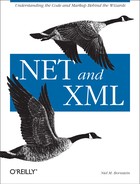Transforming an XML Document
Example 7-5 shows one of the simplest possible XSLT-related programs in C#. Given a source filename, a stylesheet filename, and a destination filename, it transforms the source into the destination using the stylesheet. It will work with any XML source file and any XSLT stylesheet.
using System.Xml.Xsl;
public class Transform {
public static void Main(string [ ] args) {
string source = args[0];
string stylesheet = args[1];
string destination = args[2];
XslTransform transform = new XslTransform( );
transform.Load(stylesheet);
transform.Transform(source, destination);
}
}
I
won’t explain in excruciating detail how this
program works, but I will point out a few important facts about the
XslTransform type. It only has one property,
XmlResolver, and two methods, Load(
) and Transform( ), but it is still one
of the most versatile pitchers in the .NET XML bullpen.
First, the Load( )
method has eight overloads. All of them load the specified XSLT
stylesheet, but each of them takes the stylesheet in a different
parameter type. The stylesheet may be specified as an
IXPathNavigable (such as
XmlDocument), URL, XmlReader,
or XPathNavigator; together, these types cover
every possible way to read an XML document. For each Load(
) method that takes one of these parameters, there is
another one taking an XmlResolver as the second
parameter. This XmlResolver is used to resolve any
stylesheets referenced in xsl:import and
xsl:include elements.
Tip
xsl:import and xsl:include
perform similar, but not identical, functions, Both allow you to
place common templates in a separate stylesheet for easy reuse.
However, xsl:import can only appear at the
beginning of a stylesheet, and any imported templates have a lower
priority than the template in the importing stylesheet. In contrast,
xsl:include can appear anywhere in a stylesheet,
and any included templates have the same priority as those in the
including stylesheet.
If an overload of Load(
) with no resolver parameter is used, the default
XmlResolver, XmlUrlResolver, is
used; if a null instance is passed in, external namespaces are not
resolved. The XmlResolver passed in is used only
for purposes of loading the specified stylesheet, and is not cached
for use in processing the XSL transform.
In version 1.1 of the .NET Framework, an
additional parameter of type
System.Security.Policy.Evidence is added to
several overloads of the Load( ) method. The
Evidence type provides information used to
authorize assembly access and code generation for any scripts
included in the stylesheet. I’ll discuss scripting
towards the end of this chapter.
Second, the Transform( ) method has a total of
nine overloads. One takes two strings, an input
URI and an output URI. The others take various combinations of
IXPathNavigable or
XPathNavigator as the first parameter, an
XsltArgumentList as the second parameter, and
nothing, a Stream, an
XmlWriter, or a TextWriter as
the third parameter. Two other overloads take only two parameters and
return the result tree as an XmlReader, which can
be navigated as you’ve already seen in Chapter 2.
Finally, in version 1.0 of the
.NET Framework, the XmlResolver property contains
the XmlResolver used when invoking the XSLT
document( ) function. The document(
) function lets you process multiple source documents in a
single stylesheet. This XmlResolver may be the
same as the one passed in to the Load( ) method,
but does not need to be. In version 1.1 of the .NET Framework, this
XmlResolver instance is passed as a parameter to
the Transform( ) method.
You may never need to do any more than this with XSLT but if you do, you should be aware that there is a lot more you can do with .NET and XSLT.
